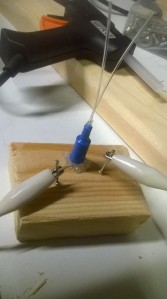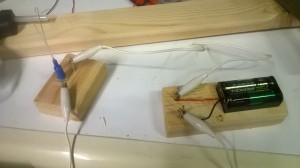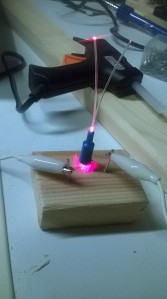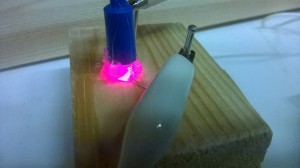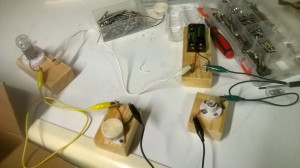Further to my last Tinkering MOOC post – I have now created more circuit blocks to play with. I’ve been away a bit so I’m catching up now – I’m still waiting for my potentiometers to arrive though 😦
I’ve been playing around with the blocks – the making them and trying some things out.
I found a fan in the pound shop so took it apart and used the motor from it to mount on a circuit block. The white thing I mounted the motor onto is part of an old roller blind – the hole in the middle seems pretty perfect to fit the motor in. I then glued the motor into place with a glue gun. I left the little plastic fan blades attached to the fan. I was hoping to get more parts from the fan – a switch or battery holder perhaps but that was not the case. Paying £1 to get a motor out was still cheaper than buying a motor though!
I also found some circuit stuff while sorting a box in my garage – particularly some LEDs and adapters to add fibre optics. I had a go at making a block with them…
It also leads me to a circuit that didn’t work (initially)- the LED has a positive and negative side and I needed to make sure they were hooked up the right way. Hard to tell when I’d bend the metal bits coming out of them and attached them nails so I just had to try both ways! Fun though, when it lit up it kind of reminded me of a little bug.
One thing I noticed about this and loved was how the light also travels through the glue from my gluegun. I want to now go and play around with this to see what shapes I can make with the glue and how well the light will travel. Certainly an ‘ooooh’ moment for me!
I played around with the kit I had, and have tried making blocks with more than one bulb on too. I think I might have a bit of a circuit block addiction now – if I pass a charity chop or pound store I have to go in and have a look if they have anything I can use. On the MOOC forum someone suggested chopping up Christmas lights and using them on blocks which I think is a fab idea!
One thing that interested me was that when I attached the motor with the fan blades to the battery the fan actually caused the block to lift slightly and it floated around the surface as far as the wires attached would let it.
One circuit I found interesting was attaching the motor with fan bits, a bulb and battery holder with two AA batteries in a series circuit. The bulb lit up but the fan didn’t move – until I knocked it! Once started it continued spinning round until I disconnected the battery from the circuit. Bizarre! Not enough power I guess.
I wanted to take this further so I also tried making the circuit pictured below. The far left is the motor with fan blades, the middle is a buzzer and the left is a bulb in a holder all attached to a battery holder containing two AA batteries.
With this circuit the bulb didn’t light, the fan didn’t spin (even when nudged), but the buzzer did sound! I think I need to add more power to the circuit to get all three to work? The electricity must be passing through the motor and bulb though as the buzzer wouldn’t work otherwise. Alas all the other AA batteries seem to have disappeared so I’ll try it out with more when I’ve had the opportunity to buy some more. Interesting though.
These blocks take a little while to make but are so rewarding! They are a bit addictive too! Playing with circuits is also lots of fun! I think this would be so much fun to do with people of all ages – I’d be very keen on seeing if I could take my kit to my daughters after school club for them to try out! I think it is really good to explore the blocks and can lead to a rich learning experience (it certainly has for me!). I’ve gained lots of experience by making the blocks, opening up my imagination to think about fun and interesting things I could put on the blocks (like the LED fibre optic thing) as well as standard things like bulbs, motors etc…



